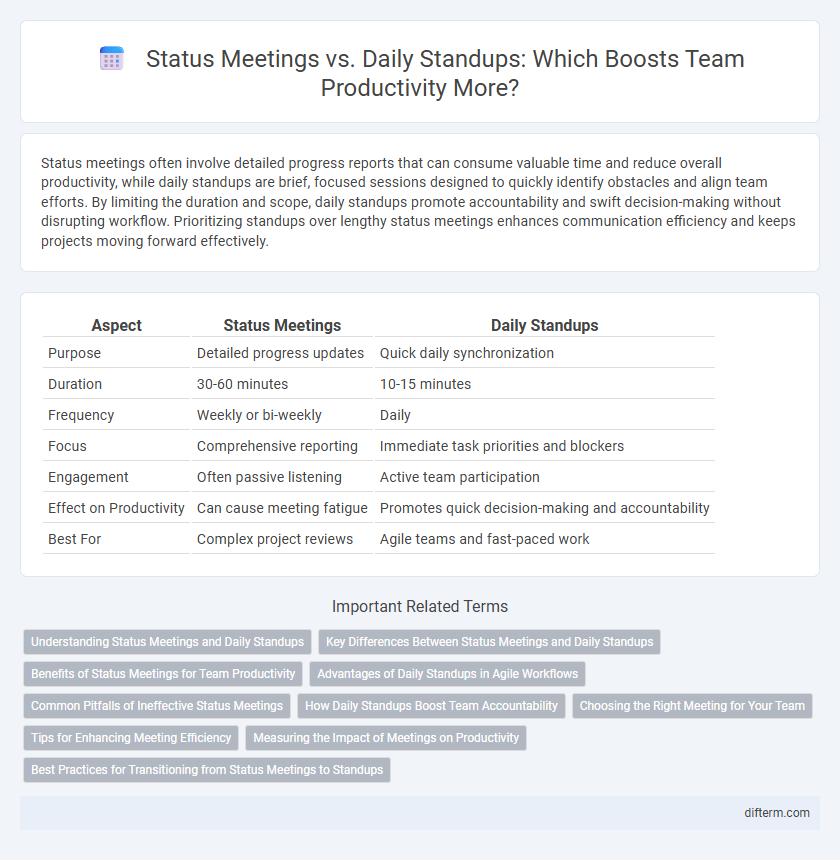Status meetings often involve detailed progress reports that can consume valuable time and reduce overall productivity, while daily standups are brief, focused sessions designed to quickly identify obstacles and align team efforts. By limiting the duration and scope, daily standups promote accountability and swift decision-making without disrupting workflow. Prioritizing standups over lengthy status meetings enhances communication efficiency and keeps projects moving forward effectively.
Table of Comparison
| Aspect | Status Meetings | Daily Standups |
|---|---|---|
| Purpose | Detailed progress updates | Quick daily synchronization |
| Duration | 30-60 minutes | 10-15 minutes |
| Frequency | Weekly or bi-weekly | Daily |
| Focus | Comprehensive reporting | Immediate task priorities and blockers |
| Engagement | Often passive listening | Active team participation |
| Effect on Productivity | Can cause meeting fatigue | Promotes quick decision-making and accountability |
| Best For | Complex project reviews | Agile teams and fast-paced work |
Understanding Status Meetings and Daily Standups
Status meetings typically involve comprehensive updates from team members and are scheduled less frequently, allowing for detailed project reviews and problem-solving discussions. Daily standups are brief, time-boxed sessions designed to align team members quickly on progress, obstacles, and priorities for the day. Both formats enhance productivity by fostering communication, but daily standups promote faster issue resolution and continuous alignment.
Key Differences Between Status Meetings and Daily Standups
Status meetings typically focus on detailed project updates, involving in-depth discussions and longer durations, while daily standups are brief, time-boxed meetings aimed at quickly synchronizing team members' tasks and identifying blockers. Status meetings often include a wider audience and cover progress reports, whereas daily standups emphasize immediate team coordination and problem-solving. The frequency also differs, with status meetings occurring weekly or biweekly, in contrast to daily standups held every workday to maintain continuous workflow momentum.
Benefits of Status Meetings for Team Productivity
Status meetings offer structured updates that help teams identify progress and obstacles, enhancing overall productivity through clear communication. They provide a dedicated time for detailed discussion, fostering alignment on project goals and deadlines. Regular status meetings reduce misunderstandings and ensure accountability, leading to more efficient task management and timely problem resolution.
Advantages of Daily Standups in Agile Workflows
Daily standups enhance agile workflows by fostering real-time communication and quick identification of blockers, enabling teams to maintain momentum and adapt swiftly to changes. These brief, focused meetings promote accountability and transparency without consuming excessive time, unlike longer status meetings. Emphasizing continuous progress and collaborative problem-solving, daily standups drive productivity and keep project goals aligned.
Common Pitfalls of Ineffective Status Meetings
Ineffective status meetings often suffer from lack of clear objectives, leading to time wasted on irrelevant updates and extended discussions. Participants may disengage due to repetitive information and insufficient action items, reducing overall team productivity. Daily standups, when properly structured, minimize these pitfalls by promoting concise communication and immediate problem-solving.
How Daily Standups Boost Team Accountability
Daily standups boost team accountability by fostering consistent communication and clear progress tracking within short, focused meetings. These brief sessions encourage team members to share updates, obstacles, and commitments openly, creating a transparent environment that drives responsibility and proactive problem-solving. By contrasting with longer, less frequent status meetings, daily standups maintain momentum and ensure team alignment on goals and deadlines.
Choosing the Right Meeting for Your Team
Status meetings often involve detailed updates and typically last longer, making them suitable for large teams managing complex projects with multiple dependencies. Daily standups are brief, time-boxed gatherings designed to quickly synchronize team progress and identify blockers, ideal for agile environments prioritizing rapid iteration. Selecting the right meeting format depends on team size, project complexity, and the need for efficient communication to enhance overall productivity.
Tips for Enhancing Meeting Efficiency
Status meetings often become lengthy and redundant, whereas daily standups prioritize brevity and goal alignment to enhance team productivity. To improve meeting efficiency, set a strict time limit of 15 minutes, focus exclusively on key updates, and use a structured agenda to keep discussions on track. Employing digital tools like task trackers or shared dashboards can streamline information sharing and reduce unnecessary follow-ups.
Measuring the Impact of Meetings on Productivity
Status meetings often consume more time due to extended updates, which can reduce overall productivity if not strictly timeboxed. Daily standups, limited to 15 minutes, improve team alignment and problem-solving speed, directly enhancing work output efficiency. Measuring meeting impact involves tracking key performance indicators like time spent in meetings, task completion rates, and team engagement levels to optimize productivity workflows.
Best Practices for Transitioning from Status Meetings to Standups
Switching from status meetings to daily standups improves team productivity by promoting concise, focused communication that highlights current progress and immediate challenges. Best practices include setting strict time limits, having each member answer three key questions--what they did yesterday, what they'll do today, and any blockers--and holding standups at the same time each day to build routine. Utilizing tools like digital Kanban boards or task trackers during standups enhances visibility and accountability, ensuring seamless project flow.
Status meetings vs Daily standups Infographic

 difterm.com
difterm.com